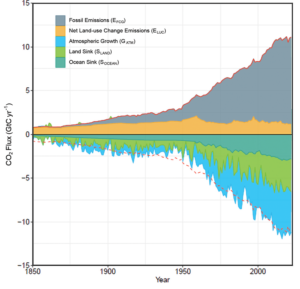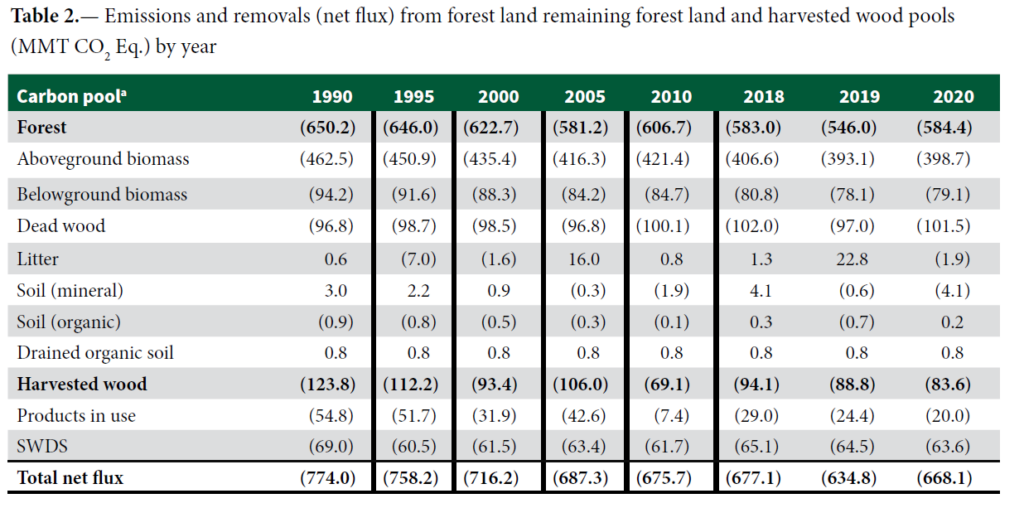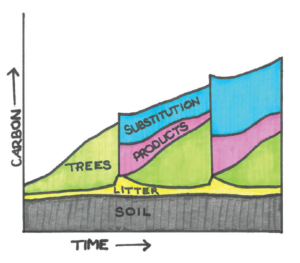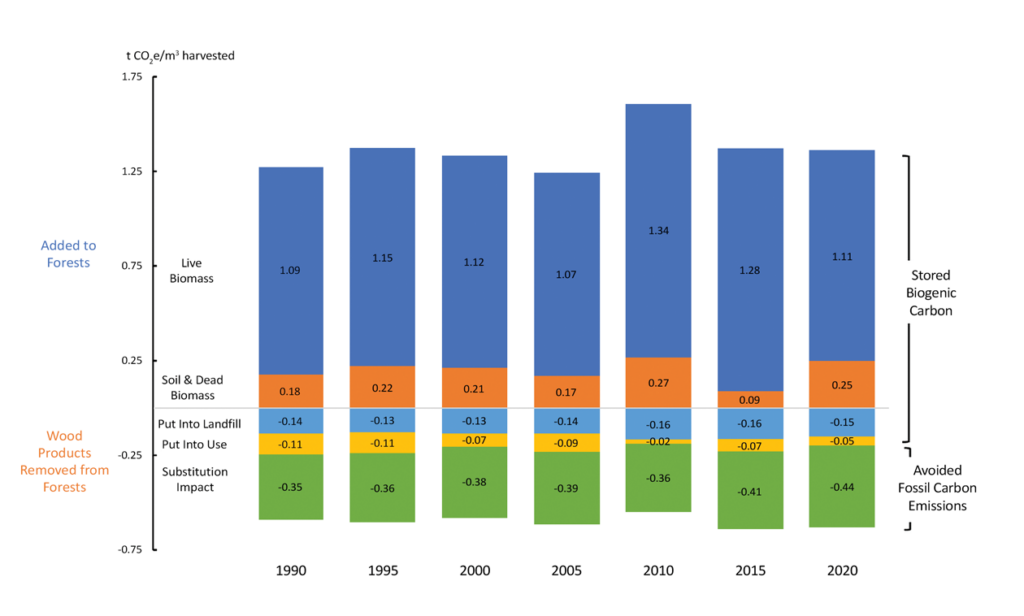Forests are an important part of global climate dynamics—the growth of trees influences, and is influenced by, the climate. One result of increasing concern about global climate change is that there is now a market for carbon that includes programs to pay forest landowners to change how they manage their forests. More money for forest landowners and mitigating climate change seems like a ‘win-win’ scenario; however, there is an important forest carbon benefit that currently isn’t getting counted: wood products substitution. This effect is important and, although it is challenging to quantify, we need to fully account for the carbon impacts of wood products—including substitution—if we are to get the full climate benefits of our forests.

What is Carbon?
Carbon the element is the basic material of life on earth, but the word ‘carbon’ is also shorthand for other concepts in conversations about forests and climate change. For example, the main driver of climate change is ‘carbon,’ a reference to the emissions of carbon dioxide gas (CO2) from the burning of fossil fuels (Figure 1). Carbon dioxide is one of the greenhouse gases in the atmosphere that keeps the earth warm by trapping solar energy.
Carbon sequestration occurs when trees grow by capturing carbon dioxide gas (via photosynthesis) and converting it into sugar, which is then converted into other materials such as wood.

Biogenic carbon refers to the carbon in living and dead plants. Fossil carbon is the carbon in coal, oil, and natural gas. Biogenic carbon has recently been sequestered from the atmosphere—the oldest trees are only thousands of years old, and biogenic carbon will mostly be released again soon, when the trees rot or burn—likely within the next few centuries or millennia. Fossil carbon was sequestered by plants millions of years ago and, if it weren’t combusted for fuel, would have remained stored in the ‘fossil’ deposits indefinitely.
Carbon (dioxide gas) removal from the atmosphere reduces the greenhouse effect. One tree doesn’t do much by itself, but the many trees growing together in the world’s forests result in significant climate impacts. For example, in the United States, our forests remove more than 600 million tonnes of carbon dioxide (TgCO2) each year, an amount equivalent to more than 10% of our nation’s fossil carbon emissions (Figure 2).
Forest carbon storage occurs when plant tissue accumulates in the forest—including the wood in living and dead tree stems, roots and leaves, and their breakdown products in and on the soil (litter). Dry wood material (i.e. cellulose, etc.) is about 50% carbon by weight. The carbon stored in wood can be calculated by determining the volume of wood (m3), using the dry wood density to determine wood mass (kg), then multiplying by 50% to get carbon content (kgC), and then multiplying this by 3.67 to get the mass of the carbon dioxide equivalent (kgCO2e).

A metric tonne of CO2e is the most common carbon unit bought and sold in the carbon market. This market has developed to allow buyers to compensate (‘offset’) their greenhouse gas emissions with ‘carbon credits’. A carbon credit represents reductions in atmospheric carbon levels, either from reducing carbon emissions to the atmosphere (e.g. building a windmill to produce electricity instead of burning coal), or by removing carbon (dioxide gas) that is already in the atmosphere (e.g. growing trees in a forest). The carbon market includes buyers who are required by law to reduce their net carbon emissions (the ‘compliance market’) and those who purchase credits by choice (the ‘voluntary market’). The specifics of the types, measurements, and value of carbon market products vary greatly around the world, but forest-related carbon programs are among the largest by volume and most important by monetary value sources of the carbon credits that are sold in the voluntary carbon market (Figure 3).
There are many forest carbon programs, with many variations, and currently, no binding universal standards for these programs. However, these programs often involve payments to forest landowners to apply ‘improved forest management’ practices that result in greater carbon storage in the forest. The specifics vary by the program but usually include reduced or delayed harvesting of trees. This makes sense because harvest reduces the carbon stored in forests because wood is removed from the site, and because the harvest disturbance increases decomposition of the ‘slash’ (treetops and branches) and other plant materials that have accumulated.

What About Wood Carbon?
Wood products have multiple carbon impacts. As mentioned, tree harvest reduces forest carbon storage levels, at least for a time. But wood products also store carbon—both in use (your wooden kitchen table is ½ carbon by weight) and after disposal (much of the wood in a landfill doesn’t rot). This carbon storage in wood products is less than what is lost at harvest but can remain stored for a very long time. For example, in U.S. government reporting of forest carbon storage, wood products of various types are assigned specific half-lives (a few years for paper, decades for building materials) but then, once disposed of in landfills, much of the carbon in products is assumed to be stored forever. In the U.S., this adds up to a lot of wood product carbon storage (84 TgCO2e; Figure 2).
Wood products also provide useful alternatives to other materials, and this has carbon implications. Non-wood materials usually require more energy inputs, and this energy is mostly sourced from fossil fuels. The use (burning/combustion) of these fossil fuels releases additional carbon dioxide gas to the atmosphere—i.e. the opposite of carbon storage. Thus, using wood products instead of alternative materials results in a carbon substitution effect because using wood avoids some fossil carbon emissions.
The various carbon pools associated with a forest area are illustrated in combination in Figure 4, which represents a general forest area beginning after a clear-cut and growing through two subsequent harvests. The biogenic carbon stored in the soil (grey) is stable over time, but harvest of the trees (green) greatly reduces the carbon stock in the forest. This ‘trees’ carbon stock rebounds as the trees grow back, while the extra litter (yellow) that is introduced at harvest decomposes. This picture also accounts for the biogenic carbon stored in harvested wood products (pink). A portion of these products degrades over time, releasing biogenic carbon back to the atmosphere (by burning or rotting) but some of the product remains as a stable carbon store in long-term use or in landfills. Finally, the substitution (blue) sections represent the amount of avoided fossil carbon emissions due to using wood in place of other materials. This portion is a large share of the total, and it accumulates over time: each harvest provides another opportunity to use wood instead of steel, concrete, plastic, and glass. Note that the substitution component is the only carbon in this picture that represents (avoided emissions of) fossil carbon; all the other pools are stores of biogenic carbon.
The United States is the world’s largest producer of wood products, and these wood products together provide a huge carbon substitution effect: 188 TgCO2e of fossil carbon emissions avoided by using wood products in 2020. This substitution benefit is only a rough estimate, partly because it hard to know what alternative materials some wood products are substitutions for—what could we use instead of toilet paper? But, even with this uncertainty and some conservative assumptions (e.g. in this case, no carbon substitution benefit for toilet paper), this substitution impact in the United States is large relative to the other forest carbon and wood product carbon storage benefits that are currently reported (Figure 5).

Wood Substitution Isn’t on the Carbon Market
Unfortunately, forest carbon programs do not yet reward forest landowners or industry for the ‘substitution effect’ of the wood products that their forests provide. And, because of the current emphasis on increasing forest-site carbon storage, the harvest of products may in fact be discouraged. However, it would be possible for the wood substitution effect to be assigned a carbon value. The carbon market already includes credits from Renewable Energy projects (Figure 3), for example by supporting the construction of windmills and solar panels that offer substitution effects by providing alternatives to burning fossil carbon to produce electricity. Wood products’ substitution effects are similar.
The state of Georgia has a new law that seeks to document potential carbon offsets for wood in buildings, including credits for the wood products substitution effect . My colleagues and I have recently estimated the potential financial impacts of this idea for buildings made with cross-laminated timber panels and other ‘mass timber’ technology (Figure 6). If a market developed for these carbon offsets, the money generated could provide significant incentives to use more wood in buildings.

Additionality and the Future of the Forest Industry
One of the challenges with rewarding producers for the carbon value of their wood products is the ‘additionality’ criterion that is commonly applied to carbon offsets. Additionality requires that the carbon payment must fund changes (e.g., changes in forest management) that result in ‘additional’ carbon storage (e.g., delaying harvest to increase forest carbon storage). However, as explained, wood products already provide huge carbon benefits via their storage and substitution effects, thus the carbon saved is not generally considered ‘additional.’ The carbon in mass timber buildings could be additional, given that steel and concrete are the standard option for tall buildings. However, most wood harvest is for traditional wood use options such as residential building construction and paper packaging. Thus, the avoided emissions carbon benefits of forests are like clean air and water: forests and the forest industry have been providing them to society for free.
However, simply because we have received the carbon benefits of forest products up to now doesn’t mean they are guaranteed for the future. The hardwood forest industry in the eastern United States is currently dropping to record low rates of production, while the volume of wood in the forests continues to grow. In this unfavorable supply/demand economic context, landowners face a choice between maintaining working forests and the conversion of their forestland to other, perhaps more profitable, uses. It is a mistake to take the future carbon benefits of forest products for granted.
Carbon Markets to Support Climate Smart Forestry
Climate Smart Forestry is a term that has been introduced to explicitly recognize the multiple climate benefits of forests, including the substitution effect of using wood products (Nabuurs et al. 2017). Unfortunately, we don’t yet have a carbon program for forest landowners that recognizes this holistic approach. But, fortunately, in the voluntary carbon market folks are free to come up with new ways of doing things. We need new carbon programs that include wood products substitution!
References
- Friedlingstein, P. et al. 2023. Global carbon budget 2023, Earth Syst. Sci. Data, 15, 5301–5369, https://doi.org/10.5194/essd-15-5301-2023.
- Forest Trends’ Ecosystem Marketplace. 2023. State of the voluntary carbon markets 2023. Washington DC: Forest Trends Association.
- McKinley DC et al. 2011. A synthesis of current knowledge on forests and carbon storage in the United States. Ecological applications. 2011 Sep;21(6):1902–24.
- Nabuurs, GJ et al. 2017. By 2050 the mitigation effects of EU forests could nearly double through climate smart forestry. Forests. Dec 6;8(12):484.
- Taylor A et al. 2023. Carbon credits for mass timber construction. BioProducts Business 8(1):1–12. ISSN 2378-1394. https://doi.org/10.22382/bpb-2023-001.
- Taylor A et al. 2024. Substitution estimates for wood products in the United States, 1990 to 2020. Forest Products Journal (2023) 73 (4): 362–369. https://doi.org/10.13073/FPJ-D-23-00036.
















